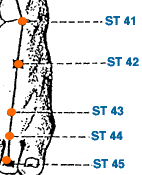ST 41
Acupuncture Point Theory
ST 41 Acupuncture Point Applications and Theory
 The acupuncture point "ST 41" , 解谿, is represented by "Jiexi" in pinyin and "Ravine Divide" in english and may be found:
The acupuncture point "ST 41" , 解谿, is represented by "Jiexi" in pinyin and "Ravine Divide" in english and may be found:
On the midpoint of the transverse crease of the ankle, approximately level with the tip of the external malleolus, in a depression between the tendons of extensor digitorum longs and hallucis longus.
Of many possible clinical applications, it may be considered to influence the following issues/symptoms:
- Opposite end of channel issues (i.e. head/face) - swelling, headache, dizziness / vertigo.
- Abdominal pain, bloating, constipation.
- Can aid groundedness and focus - ADD/ADHD, mania, restlessness, palpitations, epilepsy.
- Local point for ankle issues - sprains, inflammation, motor impairment, foot pain, pain in the 1st and 2nd toes.
St 41 has the following theoretical associations which serve as important guideposts in designing an effective treatment protocol:
- Jing River Point
- Fire Point
Explore st 41 functional grouping theory - Five Shu, or read all point categories and related theory.
A single acupuncture point is not commonly thought of as an empirical way to influence a TCM diagnostic pattern. ST41, however, is a strong candidate to be incorporated into an acupuncture protocol for patients who exhibit: Phlegm Misting the Heart
ST 41 may potentially be used, in coordination with a well designed acupuncture treatment protocol, to influence the following conditions: Abdominal Pain, Ankle Pain, Attention Deficit Disorder (ADHD - ADD), Constipation, Dizziness (Vertigo), Epilepsy (Seizure), Headache, Manic Depression and/or Palpitations
While not necessarily valid clinically, GB 40 (Local point for issues of the lower limbs a/or an…), LV 4 (Generally, moves stagnation and clears heat - Hep…) and SP 5 (Tonifies the spleen and resolves dampness - letha…) are nearby.
All Content 1999-2024
Chad J. Dupuis / Yin Yang House
Our Policies and Privacy Guidelines
Our Affiliated Clinics
